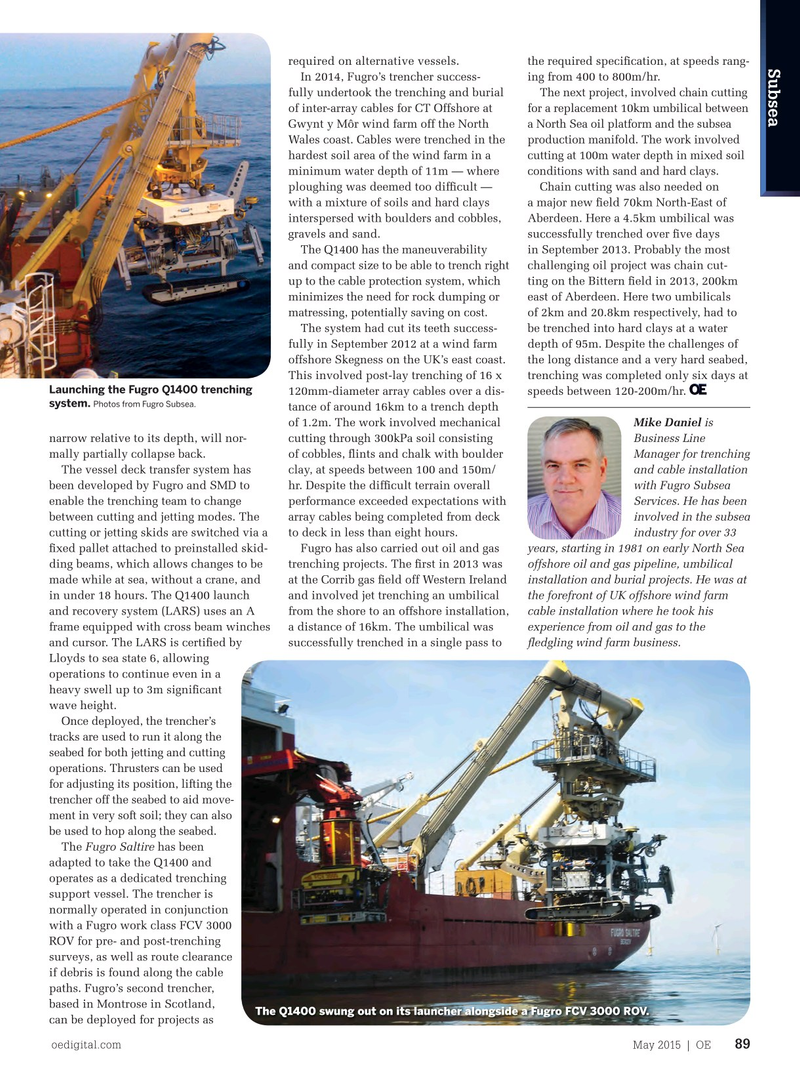
Page 87: of Offshore Engineer Magazine (May/Jun 2015)
Read this page in Pdf, Flash or Html5 edition of May/Jun 2015 Offshore Engineer Magazine
required on alternative vessels. the required speci? cation, at speeds rang-
SubseaEyebrow
In 2014, Fugro’s trencher success- ing from 400 to 800m/hr.
The next project, involved chain cutting fully undertook the trenching and burial for a replacement 10km umbilical between of inter-array cables for CT Offshore at a North Sea oil platform and the subsea
Gwynt y Môr wind farm off the North production manifold. The work involved
Wales coast. Cables were trenched in the cutting at 100m water depth in mixed soil hardest soil area of the wind farm in a conditions with sand and hard clays. minimum water depth of 11m — where ploughing was deemed too dif? cult — Chain cutting was also needed on with a mixture of soils and hard clays a major new ? eld 70km North-East of interspersed with boulders and cobbles, Aberdeen. Here a 4.5km umbilical was gravels and sand. successfully trenched over ? ve days
The Q1400 has the maneuverability in September 2013. Probably the most and compact size to be able to trench right challenging oil project was chain cut- up to the cable protection system, which ting on the Bittern ? eld in 2013, 200km minimizes the need for rock dumping or east of Aberdeen. Here two umbilicals matressi ng, potentially saving on cost. of 2km and 20.8km respectively, had to
The system had cut its teeth success- be trenched into hard clays at a water fully in September 2012 at a wind farm depth of 95m. Despite the challenges of offshore Skegness on the UK’s east coast. the long distance and a very hard seabed,
This involved post-lay trenching of 16 x trenching was completed only six days at
Launching the Fugro Q1400 trenching 120mm-diameter array cables over a dis- speeds between 120-200m/hr.
Photos from Fugro Subsea.
system. tance of around 16km to a trench depth
Mike Daniel is of 1.2m. The work involved mechanical narrow relative to its depth, will nor- cutting through 300kPa soil consisting
Business Line mally partially collapse back. of cobbles, ? ints and chalk with boulder
Manager for trenching
The vessel deck transfer system has clay, at speeds between 100 and 150m/ and cable installation been developed by Fugro and SMD to hr. Despite the dif? cult terrain overall with Fugro Subsea enable the trenching team to change performance exceeded expectations with
Services. He has been between cutting and jetting modes. The array cables being completed from deck involved in the subsea cutting or jetting skids are switched via a to deck in less than eight hours. industry for over 33 ? xed pallet attached to preinstalled skid- Fugro has also carried out oil and gas years, starting in 1981 on early North Sea ding beams, which allows changes to be trenching projects. The ? rst in 2013 was offshore oil and gas pipeline, umbilical made while at sea, without a crane, and at the Corrib gas ? eld off Western Ireland installation and burial projects. He was at in under 18 hours. The Q1400 launch and involved jet trenching an umbilical the forefront of UK offshore wind farm and recovery system (LARS) uses an A from the shore to an offshore installation, cable installation where he took his of this is delivered through variable frame equipped with cross beam winches a distance of 16km. The umbilical was experience from oil and gas to the speed drive electric motors to direct- and cursor. The LARS is certi? ed by successfully trenched in a single pass to ? edgling wind farm business. drive water pumps. The jetting tool has Lloyds to sea state 6, allowing twin-legged parallel jet swords and can operations to continue even in a trench up to 3m deep in soil conditions heavy swell up to 3m signi? cant from 5-100kPa using 2m or 3m jetting wave height.
Once deployed, the trencher’s swords, with the Q1400 system capable tracks are used to run it along the of accommodating pipelines, cables and seabed for both jetting and cutting umbilicals up to 900mm in diameter. operations. Thrusters can be used
With pre-laid rigid pipe the trenching for adjusting its position, lifting the jet legs ? uidize the soil on either side of trencher off the seabed to aid move- the pipe causing it to sink into the sea- ment in very soft soil; they can also bed. For trenching pre-laid ? exible pipes be used to hop along the seabed.
the Q1400 uses a 150hp, 2m x 400mm chain cutter and two loading arms, which The Fugro Saltire has been can take ? exibles, cables and umbilicals adapted to take the Q1400 and up to 250mm diameter. operates as a dedicated trenching
Back? lling can take place at the same support vessel. The trencher is time as jetting. Separate water pump normally operated in conjunction systems can either back? ll or keep the with a Fugro work class FCV 3000 trench open depending on the cli- ROV for pre- and post-trenching ent’s needs. The method of back? lling surveys, as well as route clearance depends on the soil type. With chain if debris is found along the cable cutting it back? lls naturally, because as paths. Fugro’s second trencher, the umbilical or cable is trenched with based in Montrose in Scotland,
The Q1400 swung out on its launcher alongside a Fugro FCV 3000 ROV.
the chain cutter the trench, which is very can be deployed for projects as oedigital.com May 2015 | OE 89 088_OE0515_Subsea4_Fugro.indd 89 4/20/15 8:35 PM

 86
86

 88
88